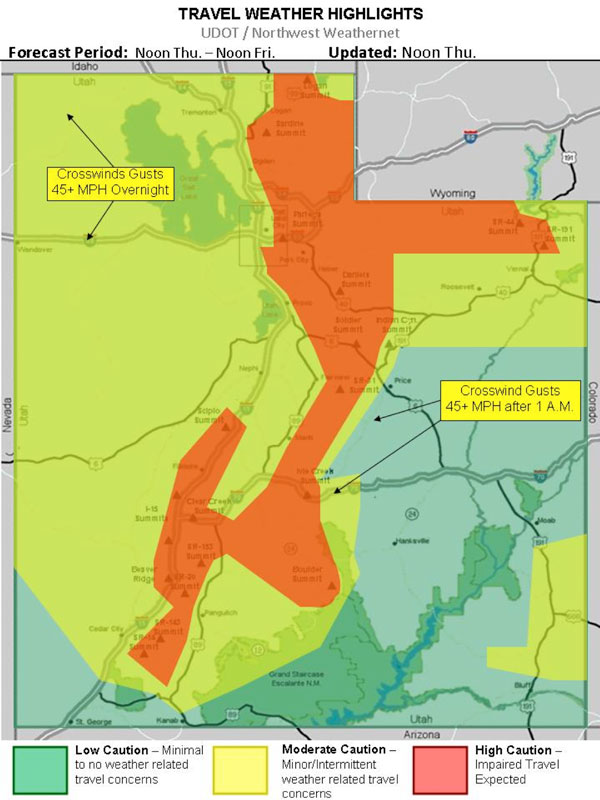Best Practices for Road Weather Management
Utah DOT Traveler Information Weather
The Utah Department of Transportation (UDOT) endeavors to provide timely, accurate and consistent weather-related traveler information so that travelers can make informed travel decisions. In response to this mission, UDOT has started the Traveler Information (TI) Weather program to provide the public with high quality road-specific forecasts before weather events, and timely road condition observations during and after events. Through human-powered forecasting, condition reporting and partnering with other agencies, this program equips travelers with road weather information, helping them to make safe travel choices.
System Components: The TI Weather program consists of three contracted meteorologists located in UDOT’s Traffic Operations Center (TOC). TI meteorologists distribute working hours among themselves to fully cover hazardous weather events. They work alongside the TOC’s maintenance and operations weather forecasters (who are also contractors), but serve public motorists specifically. There are two products they provide to the public:
- Road weather impact forecasts
- Road condition reports
These products are available on the UDOT Traffic website, smartphone app, Twitter account, and on the 511 phone line.
TI meteorologists also provide customer service to public motorists with travel weather questions. Other duties include assisting with internal weather briefings for traffic operations personnel and compiling road weather data from each storm for post-event reviews. The program is joint-managed by the Weather Operations Manager and Traveler Information Manager.
System Operations: Road weather forecasts focus on expected travel impact resulting from upcoming weather. An example forecast graphic is shown here in Figure UT-1. These graphics accompany text forecasts and are posted as a Road Weather Alert on the UDOT Traffic website and app. Each segment of Utah’s state highways receives a manually-composed forecast, which provides details pertinent to travelers. The TI Meteorologists also record 511 messages which explain upcoming impacts in a way travelers can understand.
An important and unique aspect of pre-storm messaging is collaboration with the local National Weather Service (NWS) forecast office located in Salt Lake City. Forecasters from both agencies ensure the message is consistent between both agencies’ advisory products so that the public is not receiving conflicting forecasts from multiple agencies. NWS products are more visible by media and public, and in this way, the message of travel impacts can reach a much larger audience than UDOT may be able to on its own.
Road condition reports are updated hourly from the TOC and at least twice daily from plow operators in the field. Plow operator reports are favored for their on-the-ground accuracy, but they lack the timeliness the public demands. Plow operations requires a high level of focus on safety and snow/ice mitigation, especially during hazardous and changing conditions, and reporting conditions becomes a lower priority. Utilizing in-field sensors, cameras, radar, forecasting models and direct communication with field personnel, the TI meteorologist populates these reports at a high frequency for UDOT’s TI outlets. UDOT also plans to initiate a citizen reporting program in the near future.
Transportation Outcome(s): The TI Weather program has improved UDOT’s level of service for public information. It has contributed to increased road weather awareness among media and public in Utah as they begin to understand the difference between ’sensible’ weather and road weather. For example, three inches of snow forecast to accumulate on grassy terrain may or may not translate to travel impacts, depending on road temperature, precipitation intensity, mitigation strategies, and so forth. It is assumed a road weather-savvy public will make more informed travel decisions before, during and after storms. Safer travel and increased road capacity during storms is an anticipated outcome.
Communications technology has greatly increased the ability for information to be disseminated to the public in real-time, and as a result, UDOT’s road condition reports are more visible than prior technology would have enabled. Hourly updates satisfy a public need for this important safety information.
At less than $140,000 per year, the cost of providing this service is relatively minimal for the important public service. UDOT has found that human-powered forecasts and road condition reports are produced at a much lower cost than running certain types of road weather models or relying strictly on automated field devices. Despite the low program cost, the forecasts are proven to be highly accurate, enabled in large part by human interaction in the forecast and observation processes. The TI meteorologists are removing some burden from the maintenance forecasters, who have been historically been limited to providing only a small component of public weather needs. This program has been very well received and supported in UDOT.
Implementation Issues: Basic software development was required to support the system. Local meteorologists with Bachelor’s degrees were recruited for the positions.
Contact(s):
- Leigh Jones Sturges, Utah DOT Traffic Management Division, Weather Operations and RWIS Manager, 801-887-3735.
- Lisa Miller, Utah DOT Traffic Management Division, Traveler Information Manager/PIO, 801-887-3761.
Reference(s):
-
TI Weather products available at Utah DOT Road Weather web site.
-
Jones, L., G. Merrill, K. Barjenbruch, R. Graham, “Innovations in Impact-Based Wintertime Road Weather Warnings in Utah,” First Conference on Weather Warnings and Communication, Oklahoma City, June 2011.
Keywords: traveler information, road weather, RWIS, forecast, 511, website, smartphone app.
previous | next